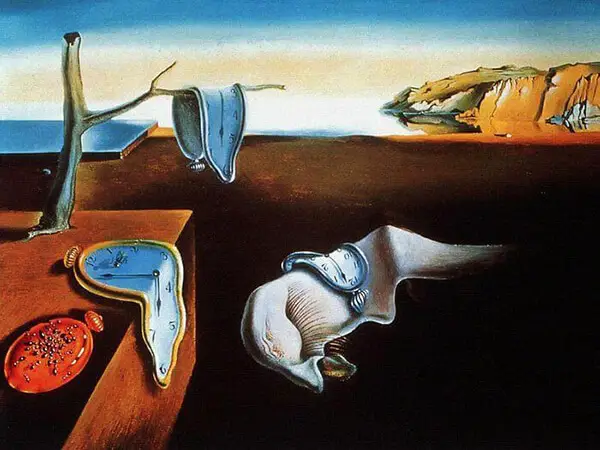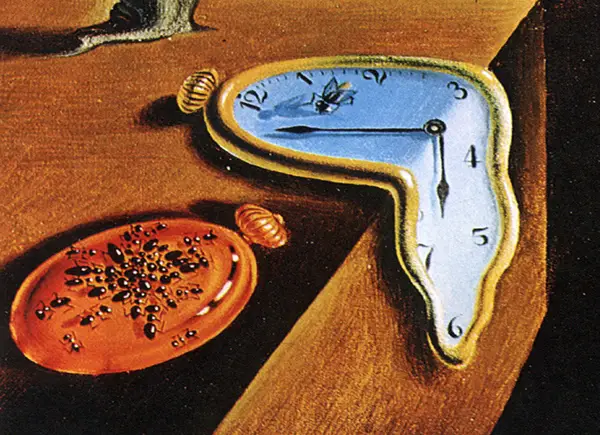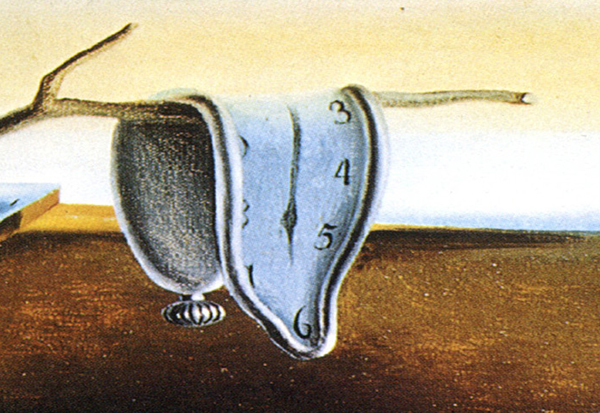The Surrealist paintings of Dali often had a dream-like feel to them, and much of this was down to the way in which the artist set up his mind before working on them. The meditative state that he desired had come from his studies in early life, covering the work of notable psychologists like Freud.
Melting clocks are the most memorable item in this painting, and the artist was quoted as describing them as "...nothing more than the soft, extravagant, solitary, paranoiac-critical Camembert cheese of space and time... Hard or soft, what difference does it make! As long as they tell time accurately..." To reduce his clocks down to cheese melting in the sun has left many experts on the artist unsure as to whether this quote was meant genuinely.
The scenery found in this painting was directly inspired from Dali's time spent in the Catalonian landscape. This region offers an artist some inspirational colours, with vivid reds and oranges. Such warmth and brightness is well suited to modern art movements such as Surrealism. Henri Matisse, Claude Monet and Vincent Van Gogh famously found similar in France with their own styles. You will again find similar boldness of colour in the background scenes of Elephants and Rose Meditative. Artist Dali would always use anything and everything that entered his mind during these periods of meditation, and would only analyse and select from them afterwards, once the initial canvases had been drafted.
Melting Clocks by Salvador Dali
Melting clocks appear in several famous surrealist paintings by Spanish artist Salvador Dali
Salvador Dali Melting Clocks refers to an object used in several of the Spanish artist's most famous paintings, with each of them included here along with a special detailed image of the melting clocks themselves, cropped from the rest of the painting. The detailed look at his melting clocks can be seen directly below whilst there are also larger versions of his classic paintings Persistence of Memory and Disintegration of the Persistence of Memory which both feature the clocks within them.
The artist explained quite what was meant by his soft, melting watches. He claimed they were "...nothing more than the soft, extravagant, solitary, paranoiac-critical Camembert cheese of space and time... Hard or soft, what difference does it make! As long as they tell time accurately...".
Surrealism for Dali involved taking standard items and making them behave in ways that you would not normally witness, be it cheese-like watches melting in the sun, or elephants with elongated limbs, carrying unrealistically heavy objects on their backs. Salvador Dali was a stylish surrealist artist who would put symbolism within most of his paintings right across his long and distinguished career. It is believed that melting clocks refers to Einstein's theory about time being relative and not fixed, with some melting cheese believed to have given the artist the idea for including these objects within his paintings. You can also find Dali paintings discussed here.
Salvador Dali clocks can be seen strewn about both his Persistence of Memory and Disintegration of the Persistence of Memory surrealist landscape paintings
The painting above offers a more helpful detailed look of the clocks and this underlines the technical talents of the artist who could accurately something as surreal as a real clock melting. Most painters are restricted by their imagination and prefer to only paint items which exist in reality whereas Dali had the technical and mental ability to achieve much more. The paintings from Salvador Dali included within this website are all available from Art.com whose site is linked to from here. We regularly use them ourselves for various Salvador Dali print reproductions and they also offer posters and stretched canvases. There is a huge gallery there of approved Dali prints and it is well worth checking out if you're looking for affordable Dali prints.
Persistence of Memory
Persistence of Memory has been held in the Museum of Modern Art (MoMA) in New York City since 1934 and is amongst the most famous oil paintings from the entire career of Salvador Dali. It is another example of his common method for setting symbolic objects against an inspiring background scene which together produce a truly memorable painting that shows of the merits of surrealist painting to the full. The Persistence of Memory came around in 1931 and whilst regarded as his finest painting, also was joined that year by other notable paintings including The Old Age of William Tell, and William Tell and Gradiva. Salvador Dali lived a highly productive life throughout the 20th century and achieved success in a wide range of art media, far beyond just the oil on canvas paintings included here. His main media included painting, drawing, photography, sculpture, writing and film.
Disintegration of the Persistence of Memory
Disintegration of the Persistence of Memory was a follow up to the 1931 classic, The Persistence of Memory and followed in 1954 after being worked on for two years. Crucifixion (Corpus Hypercubus) and Young Virgin Auto-Sodomized by the Horns of Her Own Chastity were the other two critical works to have come from Dali's career during this period. The Disintegration of the Persistence of Memory is now stored at the Salvador Dalí Museum in St. Petersburg, Florida. The painting was initially called The Chromosome of a Highly-coloured Fish's eye starting the Harmonious Disintegration of the Persistence of Memory in yet another example of the grand names given by Dali to many of his paintings which further added to their surreal and unusual nature and were meant to descriptively tell the viewer the purpose of each. Dali created both of these paintings in very small sizes which surprises most when considering the detail that he manages to fit into both.
List of Famous Salvador Dali Paintings
The paintings above cover the main topic of Salvador Dali's Melting Clocks but his career features hundreds of other classic oil paintings and mixed media works. Please see below for a summarised list of his greatest paintings, with many of them featured underneath.
- Person at the Window
- Swans Reflecting Elephants
- Female Figure with Head of Flowers
- The Ship
- The Metamorphosis of Narcissus
- Burning Giraffes in Brown
- Landscape with Butterflies
- Spain
- The Elephants
- Musical Tempest
- Dream Caused by the Flight of a Bee around a Pomegranate
- Galatea of the Spheres
- The City of the Drawers
- The Temptation of St. Anthony
- Reminescence Archeologique de l'Angelus de Millet
- Idylle Atomique
- Hallucinogenic Toreador
- Soft Watch at the Moment of First Explosion
- Cinquenta Tigre Real
- Disintegration of the Persistence of Memory
- Broken Bridge and the Dream
- Mirage
- Je ne m'en Souviens Pas
- Bacchanale Dali print
- Woman with a Head of Roses
- Rose Medidative
- Rose Meditative
- Ghost of Vermeer
- Odalisque
- Raphaelesque Head Exploded
- Geopoliticus Child
- Dream
- Apparition of a Face and Fruit Dish on a Beach
- Woman with a Head of Roses
- Apparition of the Face of Aphrodite
- Landscape With Butterflies
- Enigma Without End
- Sacrament of the Last Supper
- Young Virgin Auto-Sodomized by Her Own Chastity
- Enchanted Beach with Three Fluid Graces
- Reflections of Elephants
- Maelstrom
- Three Young Surrealist Women Holding in their Arms the Skins of an Orchestra
- Sleep
- Ma Femme Nue Regardant son Porpe Corps
- Freud's Perverse Polymorph
- Bulgarian Child Eating a Rat
- Les Trois Sphinx de Bikini
- Flower Head
- Burning Giraffe
- Soft Construction with Boiled Beans
- Muchacha de Espalda
- Idylle Atomique
- Disintegration of the Persistence of Memory
- Patient Lovers
- L'Elephante Giraffe
- Apparition of a Face and Fruit Dish on a Beach
- Naissance d'Une Divinite
- Discovery of America by Christopher Columbus Dali print
- Apparition of My Cousin Carolinetta on the Beach at Rosas
- Lincoln in Dalivision
- Santiago El Grande
- Untitled
- Piaceri Illuminati
- Face of Mae West
- Reverie
- Thousand Dreams
- Burning Giraffes in Brown
- Birth of a God
- Le Grand Masturbateur
- Lit et Deux Tables de Nuit
- Nature Morte Vivente
- Ocelot Felis Pardalis
- Atavistic Vestiges after the Rain
- Woman with a Head of Roses
- Odalisque III
- Eggs on a Plate
- Evocation of the Apparition of Lenin
- Odalisque I
- Study for The Odalisk
- Madonna of Port Lligat
- Sommeil



